22/04/2014
Eliana Dias e Lazuíta Goretti de Oliveira
| Modalidade / Nível de Ensino | Componente Curricular | Tema |
|---|---|---|
| Ensino Médio | Língua Estrangeira | Produção oral |
| Ensino Fundamental Final | Língua Estrangeira | Textos orais com marcas entonacionais e pronúncia |
| Ensino Fundamental Final | Língua Estrangeira | Grau de formalidade na escrita e na fala |
| Ensino Médio | Língua Estrangeira | Compreensão oral |
| Ensino Médio | Língua Estrangeira | Competência comunicativa: componentes linguísticos, sociolinguísticos e pragmáticos |
| Ensino Fundamental Final | Língua Estrangeira | Aspectos morfológicos, sintáticos e fonológicos |
O que o aluno poderá aprender com esta aula
conhecer, identificar e fazer uso das tag questions na língua inglesa;
confirmar informações, usando as tag questions
Duração das atividades
Conhecimentos prévios trabalhados pelo professor com o aluno
Os alunos deverão ter conhecimento dos diferentes tempos verbais, tais como, presente, passado, futuro e forma imperativa.
Estratégias e recursos da aula
- recurso multimídia;
- imagens veiculadas na internet;
- atividades individuais e em pares/grupos;
- atividades online;
- material xerocopiado;
- videos;
- slides;
- jogo
TAG QUESTIONS

Imagem disponível em; https://www.google.com.br/search?newwindow=1&site=imghp&tbm=isch&source=hp&biw=1024&bih=643&q=tag+questions&oq=TAG+QUESTIONS&gs_l=img.1.0.0j0i24l9.548.1075.0.2980.
MÓDULO 1
Atividade 1
Professor, peça para que os alunos assistam ao seguinte vídeo, disponível em http://www.youtube.com/watch?v=5LVXzsNumOI (acesso em 12.04.2014) , e façam as anotações que se fizerem pertinentes. Ao final, os alunos devem responder aos exercícios propostos. Pause o vídeo em cada momento que achar necessário para explicar ou chamar a atenção para o conteúdo que está sendo apresentado, ou ainda, para retirar possíveis dúvidas que possam sugerir. .
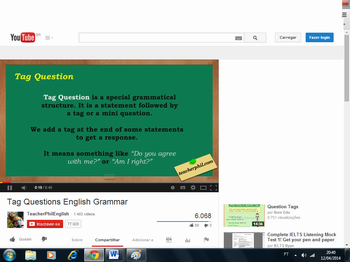
Imagem ilustrativa do referido vídeo -http://www.youtube.com/watch?v=5LVXzsNumOI
Atividade 2
Em seguida, apresente mais um vídeo que contém a continuação do conteúdo, acessando o site: http://www.youtube.com/watch?v=iyoDRLEB09U (acesso em 12.04.2014). Peça para que novamente os alunos façam anotações de dúvidas ou de partes que acharam mais interessantes no caderno e pause o vídeo nos momentos das explicações.
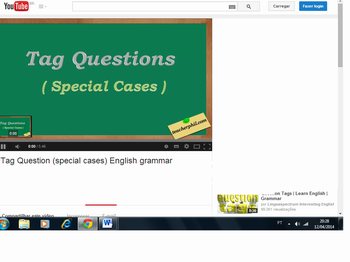
Tela inicial do referido vídeo http:// http://www.youtube.com/watch?v=iyoDRLEB09U
Atividade 3
Projete no datashow o seguinte texto, que contém as especificidades sobre o tema da aula, as quais não foram apresentadas nos vídeos anteriores. Se achar necessário, entregue esse material xerocopiado para os alunos. Peça para que os próprios alunos realizem a leitura do texto, corrigindo-os com a pronúncia e a entonação correta.
Answering Tag Questions
How do we answer a tag question? Often, we just say Yes or No. Sometimes we may repeat the tag and reverse it (They don't live here, do they? Yes, they do). Be very careful about answering tag questions. In some languages, an opposite system of answering is used, and non-native English speakers sometimes answer in the wrong way. This can lead to a lot of confusion!
Answer a tag question according to the truth of the situation. Your answer reflects the real facts, not (necessarily) the question.
For example, everyone knows that snow is white. Look at these questions, and the correct answers:
| tag question |
correct answer |
|
|
| Snow is white, isn't it? |
Yes (it is). |
the answer is the same in both cases - because snow IS WHITE! |
but notice the change of stress when the answerer does not agree with the questioner |
| Snow isn't white, is it? |
Yes it is! |
||
| Snow is black, isn't it? |
No it isn't! |
the answer is the same in both cases - because snow IS NOT BLACK! |
|
| Snow isn't black, is it? |
No (it isn't). |
In some languages, people answer a question like "Snow isn't black, is it?" with "Yes" (meaning "Yes, I agree with you"). This is the wrong answer in English!
Here are some more examples, with correct answers:
-
The moon goes round the earth, doesn't it? Yes, it does.
-
The earth is bigger than the moon, isn't it? Yes.
-
The earth is bigger than the sun, isn't it? No, it isn't!
-
Asian people don't like rice, do they? Yes, they do!
-
Elephants live in Europe, don't they? No, they don't!
-
Men don't have babies, do they? No.
-
The English alphabet doesn't have 40 letters, does it? No, it doesn't.
Tag Question Special Cases
Negative Adverbs
The adverbs never, rarely, seldom, hardly, barely and scarcely have a negative sense. Even though they may be in a positive statement, the feeling of the statement is negative. We treat statements with these words like negative statements, so the question tag is normally positive. Look at these examples:
| positive statement treated as negative statement |
positive tag |
| He never came again, |
did he? |
| She can rarely come these days, |
can she? |
| You hardly ever came late, |
did you? |
| I barely know you, |
do I? |
| You would scarcely expect her to know that, |
would you? |
Intonation
We can change the meaning of a tag question with the musical pitch of our voice. With rising intonation, it sounds like a real question. But if our intonation falls, it sounds more like a statement that doesn't require a real answer:
| intonation | |||
| You don't know where my wallet is, | do you? | / rising | real question |
| It's a beautiful view, | isn't it? | \ falling | not a real question |
Mixed Examples of Tag Questions
Here is a list of examples of tag questions in different contexts. Notice that some are "normal" and others seem to break all the rules:
-
But you don't really love her, do you?
-
This'll work, won't it?
-
Oh you think so, do you?
-
Well, I couldn't help it, could I?
-
But you'll tell me if she calls, won't you?
-
We'd never have known, would we?
-
Oh you do, do you?
-
The weather's bad, isn't it?
-
You won't be late, will you?
-
Nobody knows, do they?
-
You never come on time, do you?
-
You couldn't help me, could you?
-
You think you're clever, do you?
-
So you don't think I can do it, don't you? (British English)
-
Shut up, will you!
-
She can hardly love him after all that, can she?
-
Nothing will happen, will it?
Adaptado do site: http://www.englishclub.com/grammar/verbs-questions-tag-examples.htm (acesso em 12.04.2014)
MÓDULO 2
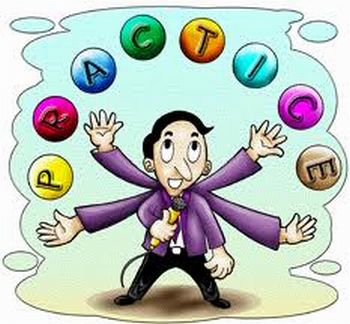
Imagem disponível em: Fonte: https://www.google.com.br/search?newwindow=1&site=imghp&tbm=isch&source=hp&biw=1024&bih=643&q=let%C2%B4s+practice&oq=let%C2%B4s+practice&gs_l=img.3..0i10i24.
happier-parents-happier-kids-and-happier-families%252F%3B360%3B334 (acesso em 12.04.2014)
Atividade 1
Projete os seguintes slides para os alunos, disponíveis em http://pt.slideshare.net/janet25/question-tag-grammarexercises?qid=0e35440a-752f-435d-ad7d-c6b2870c623d&v=qf1&b=&from_search=11 (acesso em 12.04.2014) e peça para que façam os exercícios neles propostos.
- Dispense um tempo de aproximadamente 10 minutos para isso. Permita que trabalhem em duplas. Circule pela sala, observando as dúvidas e esclarecendo-as. Para a correção, solicite a participação de todos os alunos, lendo em voz alta as frases. Observe e corrija a pronúncia das palavras, tal como a entonação, que no caso do conteúdo ora apresentado, é de suma importância.
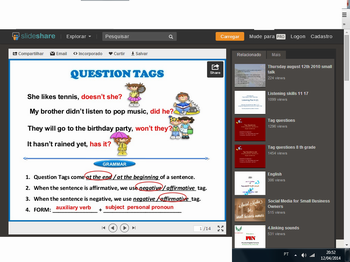
Imagem ilustrativa do slide.http://pt.slideshare.net/janet25/question-tag-grammarexercises?qid=0e35440a-752f-435d-ad7d-c6b2870c623d&v=qf1&b=&from_search=11
Atividade 2
No laboratório de informática, acesse o site http://www.englishclub.com/grammar/verbs-questions-tag_quiz.htm (acesso em 12.04.2014) e peça para que os alunos, em duplas, realizem os exercícios sobre o conteúdo apresentado na aula. Circule pela sala solucionando as dúvidas e ajudando-os, quando necessário. Observe a participação dos alunos durante todos os momentos da aula. A correção deverá ser realizada pelos próprios alunos, que deverão ficar atentos às respostas dos colegas, corrigindo-as, se necessário.
Atividade 3
Faça uma cópia do tabuleiro do jogo disponível em http://www.esltower.com/GRAMMARSHEETS/questions/Tagquestions.pdf (acesso em 12.04.2014) para cada dupla de alunos. Você pode ampliar o tabuleiro, facilitando a leitura das frases. Os alunos deverão fazer as tag questions de acordo com o número em que cair, seguindo as regras do jogo abaixo disponibilizadas. O aluno de cada dupla que chegar primeiro ao final ganhará uma prenda (que pode ser um bombom, um pirulito, uma bala, ou qualquer outra lembrança que os motive a participar). Não exite em presentear seus alunos, mesmo se a sua turma seja formada por alunos adultos. Eles também se sentirão motivados a participar do jogo e a ganhar o prêmio.
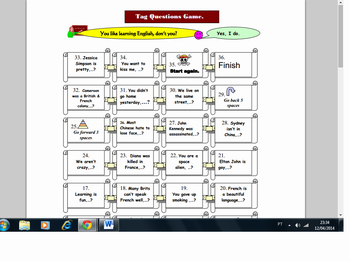
Imagem ilustrativa do jogo disponível no referido site: http://www.esltower.com/GRAMMARSHEETS/questions/Tagquestions.pdf
Recursos Complementares
Para outros vídeos, acesse:
http://www.youtube.com/watch?v=idE5on3Lv-U (acesso em 12.04.2014)
http://www.youtube.com/watch?v=GDMGZR9Qxak (acesso em 12.04.2014)
http://www.youtube.com/watch?v=IU9izSK_ArM (acesso em 12.04.2014).
Para slides sobre o tema da aula, acesse:
http://pt.slideshare.net/search/slideshow?searchfrom=header&q=question+tags&ud=any&ft=all&lang=**&sort= (acesso em 12.04.2014)
Para outras explicações sobre o tema, acesse:
http://www.englishclub.com/grammar/verbs-questions-tag.htm (acesso em 12.04.2014);
http://www.myenglishpages.com/site_php_files/grammar-lesson-tag-questions.php#.U0ngI1XIaQA (acesso em 12.04.2014)
Avaliação
- A avaliação qualitativa deverá ser realizada observando a participação e o envolvimento dos alunos em todas as atividades propostas na aula. Apresentaram interesse? Participaram ativamente?
- Para uma avaliação quantitativa, o professor poderá, também, pedir aos alunos que elaborem de 3 a 5 frases em inglês para que seus colegas possam fazer confirmações, fazendo uso das tag questions. Um aluno inicia a frase e o outro terá que confirmar a informação. As frases poderão ser escritas no quadro, facilitando a visualização de todos.
Sem estrelas 0 classificações
- Cinco estrelas 0/0 - 0%
- Quatro estrelas 0/0 - 0%
- Três estrelas 0/0 - 0%
- Duas estrelas 0/0 - 0%
- Uma estrela 0/0 - 0%
Denuncie opiniões ou materiais indevidos!
- Sugestão de aula
- Aulas
- Coleções de aulas
- Criar aula
- Criar individual
- Criar em equipe
- Gerenciar equipes
- Minhas aulas
- Orientações
- Criando equipes
- Dicas para a produção de aulas
- Reflexões pedagógicas
- Utilizando a ferramenta
- Artigo: portal educacional
- Estatísticas de uso do Portal
- Estatísticas de aulas
- Estatísticas de recursos
- Estatísticas de visitas
- Recursos utilizados em aulas
- Reflexões pedagógicas
- Informações de cursos
- Cursos
- e-Proinfo
- Materiais de cursos
- Materiais de estudo
- Artigos e publicações
- Assuntos relevantes
- Avaliações
- Ciência do cotidiano
- Destaques internacionais
- Dicas práticas
- Educação profissional e tecnológica
- Entrevistas
- Estratégias pedagógicas
- Inovações tecnológicas
- Materiais de cursos
- Materiais de evento
- Orientações e diretrizes
- Parâmetros e referencias
- Programas em vídeos
- Tutoriais
- TVescola
- Ferramentas do portal
- Fórum
- Portal do Youtube
- Compartilhando apresentação
- Ferramentas pela internet
- Blog
- Compartilhe vídeos
- Comunicação on-line
- Crie e compartilhe apresentações
- Edite e compartilhe fotos
- Escrita colaborativa
- Junte-se a uma comunicade
- Lista de discussão
- Organize e compartilhe favoritos
- Podcast
- Rádio/TVs Universitárias e outros
- Redes Sociais
- Robô Ed
PLATAFORMA FREIRE
- Bibliotecas
- Capacitação Proinfo Integrado
- Cultura
- Dicionários, tradutores e enciclopédias
- Educação inclusiva
- Geoprocessamentos
- Inclusão digital
- Infográficos
- Jogos educativos
- Jornais
- Museus
- Observatórios e planetários
- Organizações governamentais
- Plataformas educacionais
- Portais educacionais e outros
- Portal MEC
- Prêmio professores do Brasil
- Produções de professores
- Projetos de escolas
- Projetos inovadores
- Projetos sociais e educacionais
- Rádio escola
- Recursos digitais
- Revistas
- Sites de busca
- Sites temáticos do portal e TVescola
- Softwares de edição e outros
- Softwares educacionais
- Um computador por aluno

- Ryan Oksenhorn
- Ryan Snow
- Sergio Caldara
- Shane Miler
- Shane Herzog
- Sotirios Papavasilopoulos
- Stephen JB Thomas
- Tarah
- Valera Nazarov
- ZbigniewMa K Flakus


